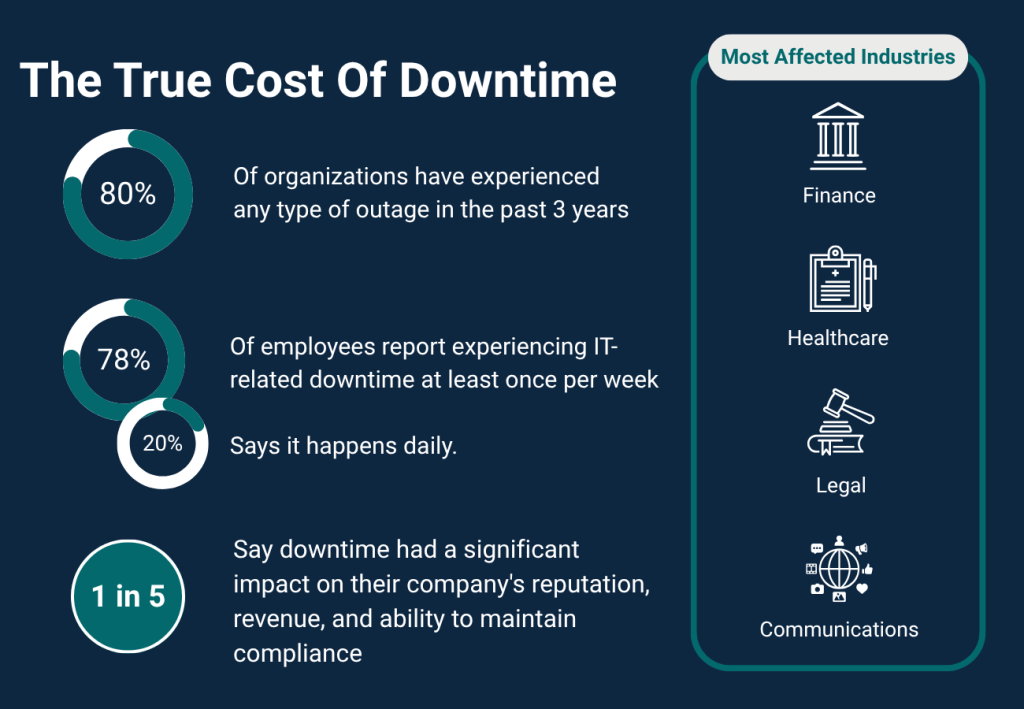What Is Downtime?
In today’s technology-driven world, uptime is no longer a luxury — it’s a necessity. Businesses rely on digital systems for everything from processing transactions and communicating with customers to managing inventory and securing sensitive data. When those systems go down, the impact of downtime extends far beyond temporary frustration. Do you know exactly how much it is costing you?
Downtime isn’t just an inconvenience — it’s a silent, expensive disruptor that affects
- Your Financial Bottom Line
- Employee Productivity
- Customer Relationships
- Business’s Reputation.
Whether it’s caused by a server crash, a cyberattack, or a power outage, every minute offline can trigger consequences. Lost revenue, missed opportunities, compliance violations, and loss of trust are just the beginning.
Understanding the full scope of downtime — and what it truly costs your business — is the first step toward protecting your operations and ensuring long-term resilience
Although downtime can’t always be prevented, businesses can implement the right systems and standards to significantly lower the risk and mitigate its impact when it does happen
1. Your Financial Bottom Line
IT Downtime is one of the most financially damaging risks a business can face. When systems go down, operations stall — resulting in lost revenue, wasted productivity, and costly recovery efforts all while expenses continue. Fixing the issue may require emergency IT support, hardware replacements, or data restoration, all of which can be expensive. On top of that, downtime can displace customer trust, leading to lost business and long-term revenue impact. It may also result in compliance violations, legal fees, or contractual penalties. Simply put, downtime doesn’t just pause your business, it drains your bottom line.
2. Productivity
Downtime can bring productivity to a halt, employees can’t access the tools, systems, or data they need to do their jobs. This leads to lost work hours, project delays, and ongoing inefficiencies that can impact operations long after everything is restored
3. Customer Relationships
Downtime has the potential to seriously impact customer experience, leading to frustration, loss of trust, and damaged loyalty. When services are unavailable or delayed, customers may turn to your competitors
4. Business Reputation
Downtime can damage your business reputation by creating a perception of unreliability, making it harder to both attract and retain customers over time.
Reducing the Risk of IT Downtime
Although downtime can’t always be prevented, businesses can implement the right systems and standards to significantly lower the risk and mitigate its impact when it does happen
1. Partner With IT Experts
While internal teams play an important role in daily operations, keeping downtime to a minimum often requires the expertise and resources of a dedicated IT partner. From proactive system monitoring to rapid incident response, partnering with IT professionals gives your business a serious edge in resilience and reliability.
Experts make a difference in…
- Faster Recovery Times
- Proactive Issue Prevention
- Scalable Support
- Security and Compliance Expertise
2. Train Employees
Technology may power your business, but your employees are the ones operating it day to day. Surprisingly, human error is one of the leading causes of downtime, from accidental file deletions and misconfigured systems to falling for phishing scams that trigger major outages.
Training employees isn’t just about onboarding them with new tools, it’s about creating a culture of awareness, responsibility, and proactive problem-solving.
Things to include in training could be…
How to spot and report technical issues quickly
Best practices for using core systems and tools
Cybersecurity awareness and prevention
How to follow backup and data handling protocols
Understanding the company’s disaster recovery plan
3. Invest in Reliable Infrastructure
At the heart of every business operation is its technology infrastructure — the servers, networks, devices, applications, and cloud platforms that keep everything running. When that infrastructure is outdated, misconfigured, or poorly maintained, it becomes a major source of downtime risk.
Investing in reliable, modern infrastructure is one of the most powerful ways to reduce disruptions and improve business continuity.
Your Infrastructure Matters Because…
Prevents System Failures
Improves Speed and Performance
Supports Remote and Hybrid Workforces
Facilitates Growth and Scalability
Enhances Security and Compliance
In Conclusion
While downtime can’t always be avoided, understanding its true impact empowers you to take proactive steps towards avoiding it. Partnering with IT experts, training your team, and investing in reliable infrastructure, to reduce risks and minimize damage when outages occur. By prioritizing uptime, you’re not just protecting your operations today, but securing the long-term resilience and success of your business.






